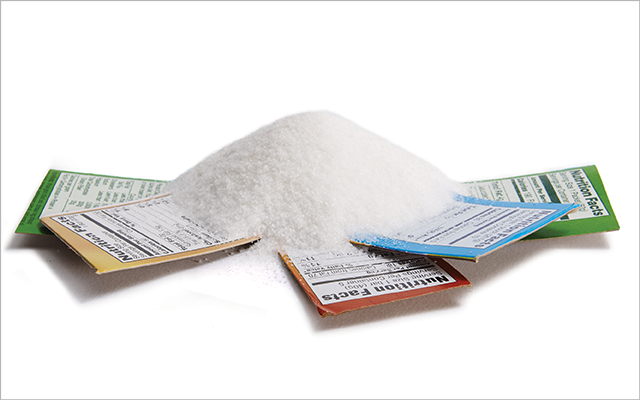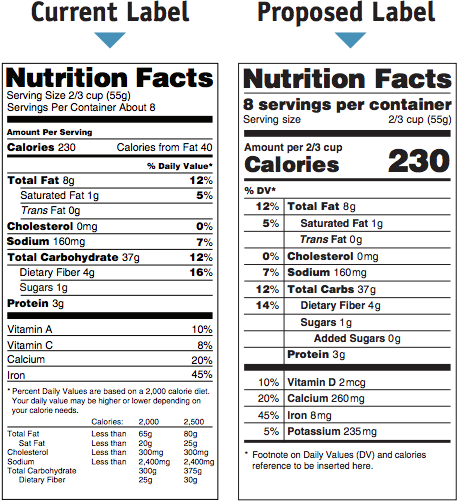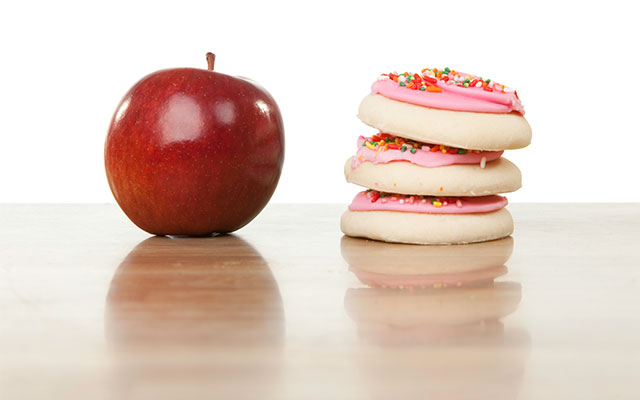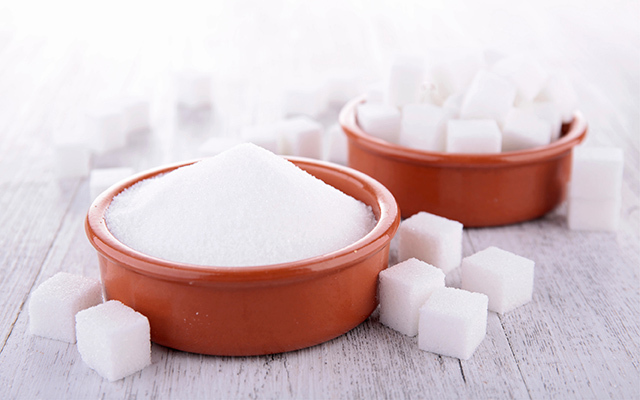You know a sugary treat when you see one — a slice of cake, a wedge of pie, a scoop of double-fudge ice cream. But you may be surprised by how much sugar you don’t see in your everyday diet.
Let’s say you start your day with low-fat yogurt topped with berries and granola (50 grams of sugar); you drizzle fat-free dressing (8 grams) on your salad at lunch, sip your favorite coffee-shop chai latte (42 grams) in the afternoon, and then tuck into a big bowl of pasta and tomato sauce (30 grams) at dinner. Between naturally occurring sugar in these foods and hidden added sugar, you’ve consumed 130 grams of sugar by the end of the day — roughly 33 teaspoons, or two-thirds of a cup — without eating anything that resembled dessert.
Nearly two hundred years ago, the average American ate about 6 pounds of sugar a year; by 1999, annual consumption had ballooned to more than 100 pounds. That much sugar is foreign in terms of human evolution and beyond our bodies’ ability to process it, says Lisa Nelson, MD, a family physician and the director of medical education at Kripalu Center in Stockbridge, Mass. “Most people are unaware of how detrimental sugar is to their health — and how pervasive it is.”
Fortunately, identifying the hidden sugar in processed foods will soon be easier, thanks to new labeling requirements approved by the Food and Drug Administration (FDA) in May 2016. Beginning in July 2018, food makers will be required to list added sugars both in grams and as a daily percentage value (DV) on nutrition labels. These two sugar line items are components of the most significant retooling of the label in 20 years. (For details of other label changes, see below.)
The new FDA label requirements will align with recommendations from the World Health Organization that adults and children limit added sugars to no more than 10 percent of daily calories. That works out to approximately 6 teaspoons (24 grams) for women and 9 teaspoons (36 grams) for men. As for children, the American Heart Association (AHA) recommends no more than 3 to 6 teaspoons (12 to 24 grams) daily, depending on weight and height, and that kids under 2 consume no added sugars.
Cutting back to 6 or 9 teaspoons of added sugars may seem daunting. But reducing sugar consumption can dramatically improve your health — and the new labels will be a big help.
Sugar Shock
Since nutrition labeling became law in 1990, the information that food manufacturers must provide has combined natural and added sugars into one lump sum presented simply as “sugars.” Consumers have had no way to decipher how much sugar is naturally occurring in a food versus how much is added during processing.
Added sugar is especially obscured in foods containing fruit or dairy because both contain naturally occurring sugars (fructose and lactose, respectively). For example, one serving of a popular mixed-berry yogurt has 26 grams (6.5 teaspoons) of sugar. But the amount that occurs naturally in the fruit and milk versus how much is added to make the yogurt taste sweeter is anyone’s guess. Food makers further complicate the problem by referring to added sugar by more than 60 different names, making it less recognizable on ingredient lists. (For sugar’s many aliases, see “61 Names for Sugar“.)
The current nutrition label also gives no indication of how much added sugar you’re getting relative to the recommended daily value — and it’s often significantly more than you think.
The current nutrition label also gives no indication of how much added sugar you’re getting relative to the recommended daily value — and it’s often significantly more than you think.
The new label will provide much-needed transparency for consumers. “Sugars have been hidden for far too long,” says Marion Nestle, PhD, MPH, professor of nutrition, food studies, and public health at New York University and author of Soda Politics: Taking on Big Soda (And Winning). “For people who read labels, this information is going to come as a big surprise.”
Jacob Teitelbaum, MD, internist, integrative-medicine physician, and coauthor of The Complete Guide to Beating Sugar Addiction, agrees: “It was a brilliant move for the FDA to separate out sugars added during processing,” he says. “This gives people the information they need to make common-sense decisions about sugar intake.”
Sweet Victory
Added sugar is the processed-food industry’s Swiss army knife — it does a little bit of everything. Sugar boosts volume, retains moisture, extends shelf life, and enhances the texture of processed foods. With that kind of utility, it’s not surprising that an estimated 74 percent of packaged foods contain added sugars. And with that kind of market presence, it’s no wonder the new labels are controversial within the sugar industry and unpopular with many processed-food manufacturers.
Indeed, the FDA’s resolution to highlight added sugars can be likened to the agency’s decision a decade ago to flag trans fat on food-package labels. “It took at least 10 years to add trans fat,” says Rachel K. Johnson, PhD, RD, a professor of nutrition and food sciences at the University of Vermont in Burlington, who served on the USDA’s Dietary Guidelines Advisory Committee in 2000. “Added sugars have been in the works even longer. This was a big win.”
Even small label changes are important because the sugar industry has a long history of using smoke and mirrors to sway public perception. A study released in JAMA Internal Medicine in September 2016 reported that, starting in 1965, a sugar-industry trade group paid to fund studies by Harvard scientists that downplayed sugar’s role in coronary heart disease, and instead blamed saturated fats and cholesterol. (For more on this, see “Sugar-Coated Lies.”)
The subterfuge continued in the 1970s, when independent research linked sugar to upticks in obesity and type 2 diabetes. With profits at stake, sugar conglomerates hired a public-relations firm to restore sugar’s image. Doctors and dentists were paid to spread the word among patients and colleagues that sugar was harmless.
The Sugar Association trade group spent hundreds of thousands of dollars bankrolling research guaranteed to cast sugar in a positive light, including a white paper that deemed sugar “harmless when eaten in reasonable amounts.” It purchased ads in newspapers and magazines touting sugar as a healthy nutrient and a way to manage weight. The illusion paid off: By the 1980s, the public’s trust in sugar was restored.
For the next two decades, the Sugar Association so effectively convinced health organizations that sugar was harmless that researchers looking to study its ill effects couldn’t find funding. The industry’s refrain was that saturated fats and excess calories, not sugar, were responsible for the rise in diet-related chronic conditions. It maintained that “a calorie is just a calorie,” and if consumers gained weight, it was because they were eating too many calories — not too much sugar.
The overall-calorie theory has many detractors, including Richard Johnson, MD, chief of the Division of Renal Diseases and Hypertension at the University of Colorado School of Medicine in Denver. In his studies on lab animals, Johnson found that fructose stimulates weight gain primarily by altering the appetite, which leads to increased food intake.
When he fed groups of mice or rats a sugar-based diet or a starch-based diet with the same number of calories, there was no difference in weight gain. The lab animals that received a sugar-based diet, however, developed many features of metabolic syndrome, including high blood pressure, insulin resistance, elevated triglycerides, and fatty liver.
To take a closer look, he restricted the number of calories in the rats’ high-sugar and high-starch diets. The sugar-eating rodents still went on to develop fatty liver and type 2 diabetes, while the starch-fed animals did not.
The results proved that all calories are not created equal. “Our studies show that sugar had an independent effect on fatty liver and diabetes when caloric intake is equal,” Johnson says. (See “How Sugar Makes You Sick,” below.)
Yet, it wasn’t until 2014, when scientists definitively linked excessive sugar consumption to heart disease in humans, that the FDA lumbered into action. The catalyst was a JAMA Internal Medicine article reporting the results of a study in which people who ate the most added sugar (more than 21 percent of daily calories — more than twice the recommended amount) were twice as likely to die from heart disease than people who ate the least, about 10 percent or less of daily calories.
It was a matter of time before the accumulation of evidence tipped the scales, says Laura Schmidt, PhD, MSW, MPH, professor of health policy at the University of California, San Francisco.
“Now we know that too much sugar doesn’t just make us fat; it makes us sick,” says Schmidt.
Label Exposé
Will the new labels offer a completely transparent view of added-sugar content? “Only time will tell how food makers will try to subvert the new labels,” says Teitelbaum.
Experts predict one loophole will lie in the use of concentrated fruit juice as a sweetener. Requirements do limit the amount of concentrated juice — which contains significantly more sugars than the same volume of unconcentrated juice — that manufacturers can use without being labeled as “added sugar.” But a certain amount of that added sugar will remain hidden.
Still, it’s important to celebrate a victory before girding for the next battle. Added sugars will be on the nutrition labels of some 700,000 packaged foods sold in the United States within the next two years. Big food makers (those with more than $10 million in annual sales) must comply by July 26, 2018; smaller companies have an extra year to get on board.
Nutrition and public-health experts believe that calling out added sugars on nutrition labels will put pressure on the industry to reformulate products, much in the way that labeling trans fat did 10 years ago.
“It is already happening,” says Nestle. “That kind of change is reason enough to have this kind of labeling.”
How Does Sugar Make You Sick?
To understand how sugar can wreak havoc on your health, take a closer look at how it’s metabolized in the body.
Table sugar (sucrose) consists of two bonded molecules: glucose and fructose. Inside the body, the bond is broken and glucose and fructose are released. The bloodstream picks up the glucose molecule and delivers it to any organ or muscle tissue that needs energy. The fructose molecule, however, can be metabolized only by the liver, which evolved to handle small amounts as early humans stumbled across the occasional stash of honey or bounty of seasonal fruit. These days the average daily fructose intake is 54.7 grams (nearly 14 teaspoons) — far more than the liver can metabolize.
“That kind of exponential dose increase distorts human physiology,” says Lisa Nelson, MD, a family physician and the director of medical education at Kripalu Center in Stockbridge, Mass.
Here are some ways that distortion manifests in poor health.
Obesity and Inflammation
Today, more than 36 percent of American adults are obese. Excess calories are not blameless, but the role of fructose may be more significant.
The liver has no choice but to turn all that excess fructose into fat, explains Richard Johnson, MD, a kidney specialist at the University of Colorado School of Medicine, and one of the nation’s top experts on the effects of fructose.
He notes that fructose is a survival nutrient present in foods such as ripe berries that enable mammals, like bears, to gain weight quickly in preparation for hibernation. “Fructose puts you in weight-gain mode,” he says.
Sugar consumption is tied to an increase in visceral (belly) fat, high blood pressure, high triglycerides, high blood sugar (a precursor of type 2 diabetes), and high cholesterol. All of these conditions fit neatly under the umbrella term “metabolic syndrome,” an inflammatory fat-storage disorder.
Meanwhile, the pancreas, which makes insulin to break down sugar, can become worn out and less able to react quickly and efficiently. Over time, this can lead to type 2 diabetes, which affects some 27 million Americans, including children.
Nonalcoholic Fatty Liver Disease
Sugary diets are also behind nonalcoholic fatty liver disease, or NAFLD. Again, because the liver is unable to process large quantities of fructose, it socks it away as fat. This causes the organ itself to become fatty. Not unlike alcohol, excess fat damages the liver. In the early stages of liver disease, the organ becomes inflamed. The scarring that ensues slowly chokes the organ’s blood flow.
“This disease didn’t even exist 35 years ago,” says Laura Schmidt, PhD, MSW, MPH, professor of health policy at the University of California, San Francisco.
Today, up to 31 percent of adults and up to 10 percent of children have NAFLD. If this trend continues, says Schmidt, NAFLD will be the No. 1 reason for liver transplant by 2020.
Unknown Health Impacts
Further physical tolls of our high-sugar diets are popping up as researchers zero in on the causes of certain cancers, Alzheimer’s disease, and disruptions in the microbiome.
“This is what a public-health crisis looks like,” warns Schmidt.
What Are the Top 5 Sources of Added Sugar in American Diets?
- 37.1%: Sugar-sweetened beverages (such as soda, specialty coffees, and sports drinks)
- 13.7%: Grain-based sweets (cookies, cakes, pies, and more)
- 8.9%: Fruit drinks (juice cocktails, fruit punch, and more)
- 6.1%: Dairy-based desserts (such as ice cream and sweetened yogurt)
- 5.8%: Candy (candy bars, jelly beans, lollipops and more)
Sugar FAQ
With any paradigm shift, questions arise. Here are a few of the most common questions and answers about added sugars.
Q | Are artificial sweeteners a good substitute?
A | The jury is still out on whether artificial sweeteners are worse than sugar, but new studies show they come with their own health concerns. A link between weight gain and artificially sweetened beverages was established years ago but, until recently, researchers struggled to understand the counterintuitive connection. New research, published in the journal Nature, suggests artificial sweeteners damage the gut’s good bacteria. A weakened microbiome is more susceptible to insulin resistance, a prediabetes condition common in those who eat too much added sugar. This may finally solve the diet-soda-weight-gain riddle. More research is under way, so stay tuned.
Q | Are honey, maple syrup, and molasses a healthier choice?
A | The body processes these sweeteners the same as all other sugars. That’s not to say you can’t have them sparingly, but it’s a mistake to think they are innocent because they are found in nature. Yes, they do contain trace amounts of beneficial nutrients but not enough to counterbalance damage done by fructose.
Q | Can I eat fruit?
A | Absolutely. Fruit does contain fructose, but fruit’s high fiber content slows digestion, which protects the liver from a blast of fructose. Fiber is the reason why a piece of fruit is a healthy snack but a glass of fruit juice is a fructose bomb. Two common sources of hidden sugars are fruit juices and fruit smoothies. A good rule is to avoid all forms of liquid sugar, even if fruit is the main ingredient. But don’t let sugar scare you off whole fruit. Whole fruit is rich in nutrients, such as vitamin C, that can mitigate fructose’s inflammatory effects. What about bananas versus kumquats? Experts say it’s not necessary to nitpick about low-sugar fruits versus high-sugar fruits. “As long as you eat it the way it came off the tree, you can trust the body to sort it out,” says internist and integrative-medicine physician Jacob Teitelbaum, MD.
Q | What is the best way to lower my sugar intake?
A | In the United States, the biggest source of added sugar is sugar-sweetened beverages. Soft drinks and sports drinks account for more than 37 percent of all added sugar in American diets. Liquid sugar is particularly harmful for metabolic disease complexes. Say you don’t drink soda? How about coffee? Coffee’s health halo is meant for black coffee, yet few people drink it black. A 20-ounce venti white chocolate mocha at Starbucks packs 75 grams (nearly 19 teaspoons) of added sugar. What about tea? A venti iced chai latte has 61 grams of sugar. Starbuck’s 31-ounce trenta is bigger than a Big Gulp. A trenta-size shaken sweet-tea lemonade delivers 76 grams of sugar.
Q | Is there a safe way to enjoy sugar?
A | Yes, it’s called dessert, says Teitelbaum. “If you’re at a restaurant and want a dessert, get one slice of death-by-chocolate and share it with a couple of friends. Remember that within one to two bites the taste-bud receptors get saturated. “Take two bites and put down the fork,” he says. “Eighty percent of the pleasure is in the first two bites, and 80 percent of the problem is in the rest.”
Get Your Facts
The new FDA label requirements will give consumers more information.
- Larger, bolder type emphasizes calories and serving-size information. “Servings per container” is also presented in larger type.
- Serving sizes will be based on amounts that people actually eat, not what they should eat. For example, the reference amount used to determine a serving of soda is changing from 8 to 12 ounces.
- For packages that contain between one and two servings, nutrition information will be labeled as one serving because people typically consume it in one sitting.
- Added sugars will be listed in grams (4.17 grams of sugar equals 1 teaspoon). Added sugars will also appear as “% Daily Value.”
- The footnote explains what “% Daily Value” means — specifically, how much a nutrient in a serving of food contributes to a daily diet.
This article originally appeared as “Sweet News” in the January/February 2017 issue of Experience Life.




This Post Has 0 Comments